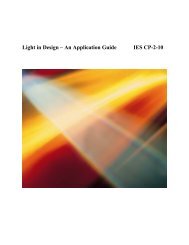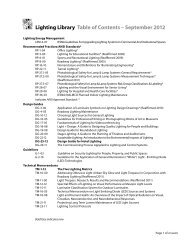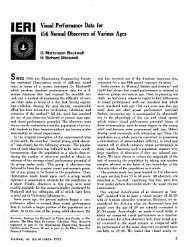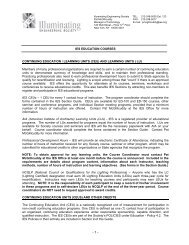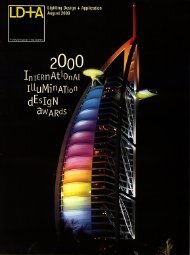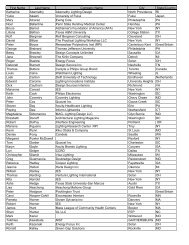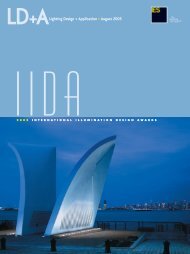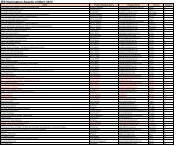Lighting and Color Introduction Lighting Science - Illuminating ...
Lighting and Color Introduction Lighting Science - Illuminating ...
Lighting and Color Introduction Lighting Science - Illuminating ...
You also want an ePaper? Increase the reach of your titles
YUMPU automatically turns print PDFs into web optimized ePapers that Google loves.
8/18/2011Correlated <strong>Color</strong> Temperature CCT• The concept of color temperature is extended to includesources which emit light that may be close to the CCTLocus - but not an exact match to a perfect radiator.• The expression correlated color temperature is used todescribe the light from such sources.• CCT is not totally accurate for characterizing light sourceswhich have narrow-b<strong>and</strong> spectral emittance curves <strong>and</strong>that do not match the blackbody curve such as a LED,CFL, HID or Linear Fluorescent sources.<strong>Color</strong> Temperature20000KBlue Northwest SkyBlue Sky with Thin White CloudsBlue Sky10000K7500K high CRIfluorescentsShort-arc Xenon7000K6000KNorth SkyOvercast North Sky5000K high CRIfluorescentsCW & CWXWW & WWXHPS5000K4000K3000K2000KNoon SunDeluxe MercuryInc<strong>and</strong>escentC<strong>and</strong>le FlameSpectral Sensitivity Corresponding to Human Eyey()= Sensitivity of humaneye to brightnessThe wavelength range visible to the human eye is 380nm to 780nm.Spectral sensitivity is specified as the average visual perception ofnumerous people with normal vision as determined by CIE. As a result,there are some differences from actual individuals, depending on theperson, race, age <strong>and</strong> whether a sample is viewed in a bright or darklocation.The Peak wavelength for brightness, y() is 555nm.8



